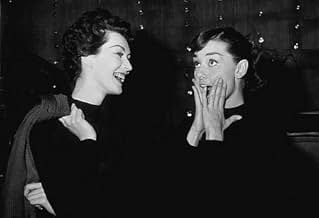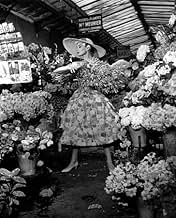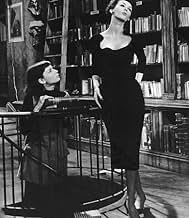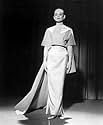NOTE IMDb
7,0/10
35 k
MA NOTE
Un défilé de mode improvisé dans une librairie entraîne une jeune libraire vers le monde de la mode.Un défilé de mode improvisé dans une librairie entraîne une jeune libraire vers le monde de la mode.Un défilé de mode improvisé dans une librairie entraîne une jeune libraire vers le monde de la mode.
- Réalisation
- Scénario
- Casting principal
- Nommé pour 4 Oscars
- 2 victoires et 10 nominations au total
Heather Ames
- Junior Editor
- (non crédité)
Fern Barry
- Southern Wife
- (non crédité)
Brandon Beach
- Fashion Show Guest
- (non crédité)
Paul Bisciglia
- Photographer
- (non crédité)
Avis à la une
Stanley Donen's "Funny Face" was one of the best musicals that came out of Paramount, a studio not known for that genre. The DVD format we watched recently seems to have been transferred with great care as the colors have a vibrant look, something that wasn't the case with the technique used during that era that made colors fade.
The film owes its appeal to Audrey Hepburn, an actress not known for being a singer, or a dancer, but who had enough charm to make the movie her own. The pairing with the great Fred Astaire pays off well because Mr. Astaire was always an actor who had enough chemistry with his leading ladies. Ms. Hepburn's costumes by Givenchy and the way she carries herself in them is one of the best assets about "Funny Face".
The other surprise of the movie is Kay Thompson, who plays the magazine editor Maggie Prescott. Ms. Thompson makes an excellent contribution to the film as the no nonsense woman who ruled what the fashions of the day should be as shown in the pages of the magazine.
The songs of George Gershwin are complimented by the original music composed for the musical by Roger Edens, Adolph Deutsch and Leonard Gershe. The great cinematography of Ray June shows Paris at its best. Thanks to Stanley Donen all the elements feel into place and we were left with this musical that will delight audiences forever.
The film owes its appeal to Audrey Hepburn, an actress not known for being a singer, or a dancer, but who had enough charm to make the movie her own. The pairing with the great Fred Astaire pays off well because Mr. Astaire was always an actor who had enough chemistry with his leading ladies. Ms. Hepburn's costumes by Givenchy and the way she carries herself in them is one of the best assets about "Funny Face".
The other surprise of the movie is Kay Thompson, who plays the magazine editor Maggie Prescott. Ms. Thompson makes an excellent contribution to the film as the no nonsense woman who ruled what the fashions of the day should be as shown in the pages of the magazine.
The songs of George Gershwin are complimented by the original music composed for the musical by Roger Edens, Adolph Deutsch and Leonard Gershe. The great cinematography of Ray June shows Paris at its best. Thanks to Stanley Donen all the elements feel into place and we were left with this musical that will delight audiences forever.
"Funny Face" was great fun during its first runs and is still a most enjoyable musical. A top notch cast headed by Audrey Hepburn and Fred Astaire make this a winner. Kaye Thompson is on hand for songs, dances and laughs, and George Gershwin's score sparkles. Filmed in part on location in Paris, "Funny Face" beautifully conveys its story of romance with elegance and charm. Smart fashion costumes, photography and choreography combine to make this a hit.
You have Audrey Hepburn, you have Fred Astaire, you have Gershwin songs. Who needs a plot?
Okay, there was something of a plot, something about a Greenwich Village girl who wants to go to Paris, talk b.s. philosophy on the Left Bank, wear black clothes and no make-up. It reads like something out of one of Woody Allen's early stories - before he wrote it!
Audrey Hepburn never knew how to look bad nor act bad. But in this she looks light-years more beautiful as the proverbial Greenwich Village used-book-store Plain Jane than any Paris fashion model - then or now.
Okay, there was something of a plot, something about a Greenwich Village girl who wants to go to Paris, talk b.s. philosophy on the Left Bank, wear black clothes and no make-up. It reads like something out of one of Woody Allen's early stories - before he wrote it!
Audrey Hepburn never knew how to look bad nor act bad. But in this she looks light-years more beautiful as the proverbial Greenwich Village used-book-store Plain Jane than any Paris fashion model - then or now.
This 1957 musical is a little odd. It has a title based on an original 1920s Gershwin musical (that included the title song) which starred Fred and Adele Astaire. It was a musical and scenic valentine to France (but only one tune in it deals with France - "Bonjour Paris!". It is a spoof on the modern fashion magazines, fashions in general, and advertising - but the spoof while sharp at times is never pushed. The opening sequence, "Think Pink," describes how Kay Thompson plans a campaign to make the American woman go for "pink" clothes, accessories, toothpaste, etc., only to admit to her assistant she personally loathes the color. It takes full advantage of the attractive face and features of Hepburn, who is convinced to be a model and help push a new line of fashions in Paris. And it makes two characters into imitations of Richard Avedon the photographer (Astaire as Dick Avory) and Jean-Paul Sartre (Michel Auclair as Prof. Emile Flostre).
Avedon was a rarity - a fashion photographer who became a great artistic portrait photographer. Astaire never is shown taking pictures of great or famous people in the film but several times he demonstrates a refinement that separates him from the rest of Kay Thompson's entourage (most of whom don't care what havoc they cause, as long as they get their jobs done). He also has enough sense to question Hepburn's accepting of "empathicalism", and it's viability. Witness his moment in the bistro pouring wine to the two old codgers who are quite pleasant to him while he insults them in English. Hepburn, of course, is so insistent on the validity of her philosophical beliefs that she rejects Astaire's warnings, and jeopardizes the fashion show.
The final blow (seemingly) to the Astaire - Hepburn relationship is when he confronts Flostre at the author's home. He knocks out the Professor, and his brutality demolishes the relationship with Hepburn. But within minutes Hepburn sees another side to Flostre which is unexpected, and suddenly realizes that Astaire may be right after all.
The character of Flostre is obviously based on that of Jean-Paul Sartre, the founder of "existentialism". Based on in some details, but not in theory. "Empathicalism" has to do with trying to empathize with others so as to have a proper response to their needs and aspirations. "Existentialism" has to do with: "An introspective humanism or theory of man which expresses the individual's intense awareness of his contingency and freedom; a theory which states that the existence of the individual precedes his essence." This is from Webster's New Collegiate Dictionary. Sartre has a more complex view of man and society, and one can plow through BEING AND NOTHINGNESS to try to understand it. In fact some critics have wondered if the Nobel Prize Winner eventually got very wrong headed about his theory. But he certainly seems a meatier philosopher than his celluloid copy.
But Flostre does have the trappings of Sartre on him. He is revered by his followers world wide (such as Hepburn). He is a man with sexual appetite (as Sartre was with his long time companion and fellow writer Simone Beauvoir). And there is some traces of an anti-capitalist, even anti-American attitude in him. It is not definitely pushed, but when Astaire and Thompson break into his house during a party, they pretend they are American share cropper singers whom Flostre had brought to France to perform for his guests. Now, we never hear what this actual pair actually would sing, but judging from their background they would have to throw in some protest songs. Sartre was very critical of the U.S.A. and capitalism (today his fans have to explain Sartre's willingness to accept Russian imperialist moves under Communism in the 1940s, 1950s, and 1960s - they find it very hard to do so).
On the whole the parts of the film work well, so I give it seven stars. Kay Thompson is best recalled for being the creator of the little girl at the Plaza "Eloise", but she shows here a highly entertaining performance as Maggie Prescott, the editor who pushes and loathes pink. The film would have been better if somehow Avedon's portrait photography had been brought into the story, possibly in a final scene with Flostre as his subject. However, even without such a sequence the film is rewarding to watch, especially in the musical numbers. Astaire does equally well with Thompson and with Hepburn as his partners here.
Avedon was a rarity - a fashion photographer who became a great artistic portrait photographer. Astaire never is shown taking pictures of great or famous people in the film but several times he demonstrates a refinement that separates him from the rest of Kay Thompson's entourage (most of whom don't care what havoc they cause, as long as they get their jobs done). He also has enough sense to question Hepburn's accepting of "empathicalism", and it's viability. Witness his moment in the bistro pouring wine to the two old codgers who are quite pleasant to him while he insults them in English. Hepburn, of course, is so insistent on the validity of her philosophical beliefs that she rejects Astaire's warnings, and jeopardizes the fashion show.
The final blow (seemingly) to the Astaire - Hepburn relationship is when he confronts Flostre at the author's home. He knocks out the Professor, and his brutality demolishes the relationship with Hepburn. But within minutes Hepburn sees another side to Flostre which is unexpected, and suddenly realizes that Astaire may be right after all.
The character of Flostre is obviously based on that of Jean-Paul Sartre, the founder of "existentialism". Based on in some details, but not in theory. "Empathicalism" has to do with trying to empathize with others so as to have a proper response to their needs and aspirations. "Existentialism" has to do with: "An introspective humanism or theory of man which expresses the individual's intense awareness of his contingency and freedom; a theory which states that the existence of the individual precedes his essence." This is from Webster's New Collegiate Dictionary. Sartre has a more complex view of man and society, and one can plow through BEING AND NOTHINGNESS to try to understand it. In fact some critics have wondered if the Nobel Prize Winner eventually got very wrong headed about his theory. But he certainly seems a meatier philosopher than his celluloid copy.
But Flostre does have the trappings of Sartre on him. He is revered by his followers world wide (such as Hepburn). He is a man with sexual appetite (as Sartre was with his long time companion and fellow writer Simone Beauvoir). And there is some traces of an anti-capitalist, even anti-American attitude in him. It is not definitely pushed, but when Astaire and Thompson break into his house during a party, they pretend they are American share cropper singers whom Flostre had brought to France to perform for his guests. Now, we never hear what this actual pair actually would sing, but judging from their background they would have to throw in some protest songs. Sartre was very critical of the U.S.A. and capitalism (today his fans have to explain Sartre's willingness to accept Russian imperialist moves under Communism in the 1940s, 1950s, and 1960s - they find it very hard to do so).
On the whole the parts of the film work well, so I give it seven stars. Kay Thompson is best recalled for being the creator of the little girl at the Plaza "Eloise", but she shows here a highly entertaining performance as Maggie Prescott, the editor who pushes and loathes pink. The film would have been better if somehow Avedon's portrait photography had been brought into the story, possibly in a final scene with Flostre as his subject. However, even without such a sequence the film is rewarding to watch, especially in the musical numbers. Astaire does equally well with Thompson and with Hepburn as his partners here.
This snappy musical teams an ageing Fred Astaire with the young and lively Audrey Hepburn, puts them in Paris with a lovely Gershwin score, and piles on the slush to create romantic confection that really is irresistible.
Audrey is at her best here, whether singing (in her own voice) How Long Has This Been Going On?', dancing wildly around a café, or looking like a mannequin in the fabulous frocks. Kay Thompson is on hand too, with her own fabulous number, Think Pink' about the trials and tribulations of being a fashion magazine editor.
It probably works best with the misty filters and the dreamy sequences, though. And Audrey is serenaded by Fred dancing beneath her window, like the dashing prince who comes to rescue Rapunzel. Musical corn perhaps, but addictive nonetheless.
Audrey is at her best here, whether singing (in her own voice) How Long Has This Been Going On?', dancing wildly around a café, or looking like a mannequin in the fabulous frocks. Kay Thompson is on hand too, with her own fabulous number, Think Pink' about the trials and tribulations of being a fashion magazine editor.
It probably works best with the misty filters and the dreamy sequences, though. And Audrey is serenaded by Fred dancing beneath her window, like the dashing prince who comes to rescue Rapunzel. Musical corn perhaps, but addictive nonetheless.
Le saviez-vous
- AnecdotesFred Astaire's character is based on photographer Richard Avedon and his wife, Doe, who, like the character "Jo Stockton," became a noted model despite her indifference toward that profession. In fact, it is Avedon who set up most of the photography for this film, including the famous face portrait of Audrey Hepburn unveiled during the darkroom sequence.
- GaffesAfter Dick kisses Jo and leaves the bookstore, Jo begins to sing "How Long Has This Been Going On". As she sings to herself while looking at the mirror in the supposedly empty bookstore, someone is reflected in the mirror moving around on the second floor of the bookstore.
- Citations
Dick Avery: When I get through with you, you'll look like... What do you call beautiful? A tree. You'll look like a tree.
- Crédits fousThe opening credits, designed by film consultant Richard Avedon, consist of traditional film credit display interspersed with live action, fashion models and photographic film.
- ConnexionsEdited into Chop Suey (2001)
- Bandes originalesOverture: Funny Face/'S Wonderful/Think Pink!
(uncredited)
Lyrics by Ira Gershwin
Music by George Gershwin
Performed by Fred Astaire
Meilleurs choix
Connectez-vous pour évaluer et suivre la liste de favoris afin de recevoir des recommandations personnalisées
Détails
- Date de sortie
- Pays d’origine
- Langues
- Aussi connu sous le nom de
- La cenicienta de París
- Lieux de tournage
- Château de la reine blanche, Coye-la-Forêt, Oise, France(wedding dress photo shoot, Dick's marriage proposal)
- Société de production
- Voir plus de crédits d'entreprise sur IMDbPro
Box-office
- Budget
- 3 000 000 $US (estimé)
- Montant brut mondial
- 1 669 $US
- Durée1 heure 43 minutes
- Couleur
- Rapport de forme
- 1.85 : 1
Contribuer à cette page
Suggérer une modification ou ajouter du contenu manquant

Lacune principale
By what name was Drôle de frimousse (1957) officially released in India in English?
Répondre




































